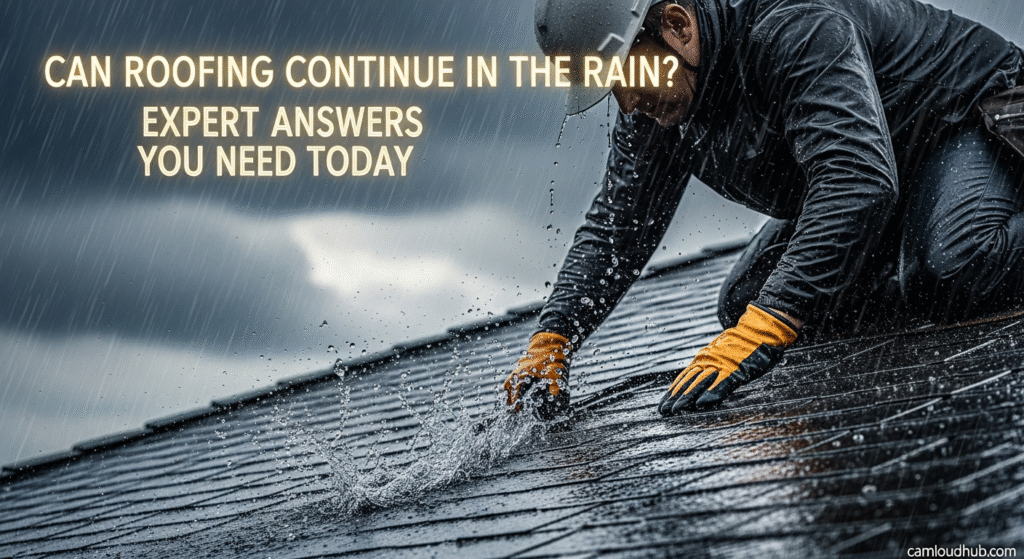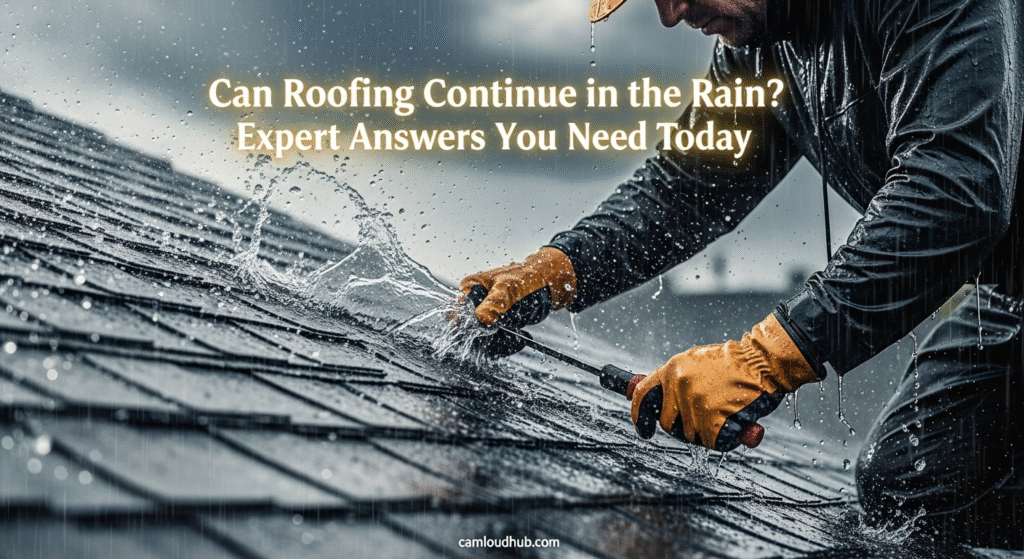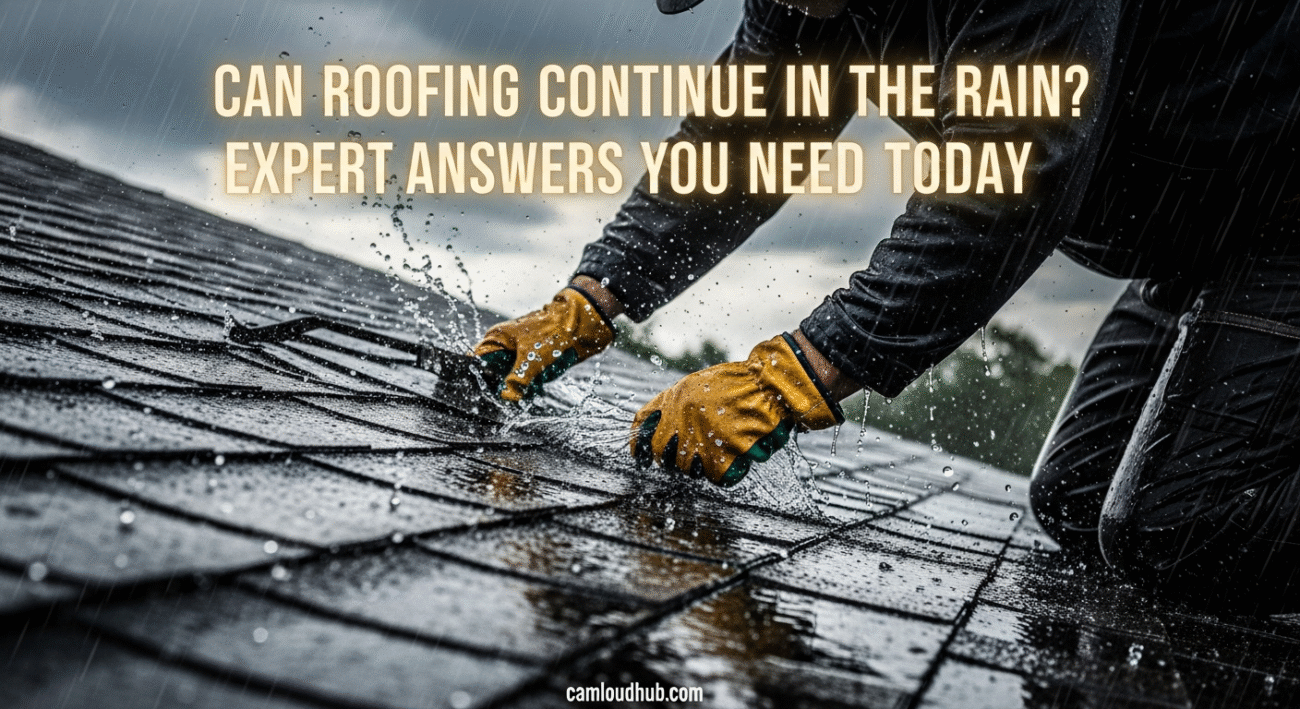The Immediate Dangers of Wet Weather Roofing
Can Roofing Continue in the Rain? Expert Answers You Need Today – Let’s be blunt: roofing in the rain is inherently risky. We’re talking about serious hazards that can affect not just the crew, but also the delicate structure beneath your roof. It’s a situation that demands extreme caution and often, a complete halt to operations. This is not a situation where corner cutting is ever acceptable.
One of the most obvious threats is slipping. A wet roof surface becomes incredibly slick, turning a routine walk into a treacherous tightrope act. Falls from heights are among the leading causes of construction injuries and fatalities, and wet weather roofing significantly amplifies this risk. No project timeline is worth a life-altering injury.
Beyond falls, there’s the danger of electrical shock. Many roofing projects involve power tools, and water and electricity are a deadly combination. Working with nail guns, saws, or other equipment in damp conditions can lead to severe accidents. Protecting equipment and personnel from accidental electrocution is paramount.
The materials themselves also suffer immensely when exposed to rain during installation. Adhesives won’t cure properly, shingles might not seal, and underlying layers can absorb moisture. This leads to compromised integrity and a roof that won’t perform as it should. Such issues invariably shorten the lifespan of your roof.

Material Matters: What Roof Types Can Handle Some Drizzle?
Different roofing materials react uniquely to moisture, and some are far more forgiving than others. However, “forgiving” is a relative term when safety is on the line. Generally, most roofing projects should be postponed in anything more than a light misty drizzle. The integrity of a new roof installation depends on dry conditions.
Asphalt shingles, by far the most common type, are incredibly sensitive to moisture during installation. Water interferes with the crucial sealing process, making them vulnerable to wind uplift. Metal roofs, while waterproof once installed, become incredibly slick when wet, posing a huge slip hazard during the work. Flat roofs might seem less affected, but even they have their own set of challenges that water exacerbates.
Understanding these material-specific challenges is key to making informed decisions. It’s not just about the surface; it’s about what happens beneath and during the entire installation process. The longevity and warranty of any new roof are tied directly to proper installation conditions.
Asphalt Shingles and the Rain Dance
Asphalt shingles are designed to shed water once installed and sealed, but installing them in the rain is a recipe for disaster. Their self-sealing adhesive strips need heat from the sun and a dry surface to properly bond. If you install them when wet, these strips simply won’t activate effectively. This means your shingles won’t seal down, leaving them susceptible to wind damage and leaks from the very first storm.
Moreover, the granules on asphalt shingles can be dislodged more easily when wet or walked on during installation. This not only affects the aesthetic but also compromises the shingle’s UV protection. Water can also seep into the underlying layers, like the felt underlayment or even the roof deck, causing swelling, warping, or mold growth before the roof is even finished. Such damage beneath the shingles is incredibly difficult to detect until it’s a major problem.
A proper wet weather roofing installation involving asphalt shingles is almost an oxymoron. Any reputable roofing contractor will tell you to absolutely avoid it. They understand the long-term consequences far too well.
Metal Roofing: A Slippery Slope
Metal roofs are renowned for their durability and sleek look, but they present unique challenges when moisture is involved. When wet, metal panels become extremely slick, turning a manageable slope into a dangerous slide. Even experienced roofers wearing non-slip footwear can lose their footing with alarming ease. The smooth, non-porous surface of metal sheeting simply offers no resistance to a wet boot.
Working with large metal panels in windy, wet conditions further complicates matters. They can act like sails, making them hard to control and increasing the risk of accidents. Dropping a panel can damage not just the panel itself but also other sections of the roof or even elements on the ground. The very nature of metal makes wet weather roofing incredibly perilous.
This isn’t to say metal roofs are bad; quite the opposite. But their installation demands specific, dry conditions for safety and precision. Any compromise translates directly to increased risk for the workers and potential damage to materials.
Flat Roofs: A Glimmer of Hope, But Be Wary
Flat roofs, often found on commercial buildings or modern residential designs, use materials like TPO, EPDM, or modified bitumen. These single-ply membranes are generally more watertight than shingles on installation, offering a slight allowance for very specific, very limited work during light precipitation. However, “limited” is the operative word here, and extreme caution is still the rule.
You might see contractors installing sections of a TPO or EPDM membrane during a light drizzle, but this is usually only for temporary, emergency patching, not a full system installation. Even then, the substrate must be completely dry, and special primers and adhesives that are less sensitive to moisture might be used. Adhesion is still crucial, and water between layers can compromise the entire system over time. Trapped moisture can lead to blisters or complete adhesion failure.
Extensive wet weather roofing on a flat roof, especially a full tear-off and replacement, is still a resounding no. The risk of water infiltration into the building structure is too high, and the quality of the final seal will be undeniably compromised. Don’t let anyone convince you otherwise for a full replacement.
Safety First: Non-Negotiables for Wet Weather Roofing
When it comes to working on a roof, safety is never a suggestion; it’s an absolute requirement. This fact only intensifies when rain enters the equation. There are certain protocols and equipment that simply cannot be bypassed, regardless of how urgent the project seems. The well-being of the roofing crew and the long-term integrity of your home hang in the balance.
Every decision made on a roof, especially during inclement weather, must prioritize preventing accidents. This means a comprehensive understanding of potential hazards and strict adherence to safety guidelines. Any perceived time-saving measure that compromises safety is a dangerous gamble, one that no reputable contractor would ever consider. It is about fostering a culture where safety is not just a policy but a deeply ingrained habit.
The stakes are simply too high to take shortcuts. Slips, falls, electrocution, and structural damage are all very real possibilities. Therefore, preparedness and strict safety protocols are the bedrock of any roofing operation. This becomes even more critical when managing the risks associated with even the slightest bit of moisture.
Essential Gear for Any Glimpse of Rain
Personal Protective Equipment, or PPE, is crucial for roofers, and it becomes even more vital when rain is present. We’re talking about more than just a hard hat. Non-slip footwear specifically designed for roofing work is a must-have, providing maximum grip on potentially slick surfaces. A proper safety harness securely anchored to a sturdy point on the roof is indispensable for preventing falls. This is a primary life-saving device.
Waterproof clothing is also essential to keep workers dry and comfortable, preventing hypothermia and maintaining focus. High-visibility gear ensures that workers are easily seen in reduced visibility conditions caused by rain. Gloves provide better grip on wet materials and tools, reducing the risk of dropping something or losing control. No piece of this gear is optional for wet weather roofing.
These items aren’t just for compliance; they are critical components in a comprehensive safety strategy. Investing in top-quality PPE for the crew is a non-negotiable for any professional roofing company. It demonstrates a commitment, not only to safety but to the quality of the work environment.
Tools and Techniques: Best Practices in Unfavorable Conditions
Even if work is minimally continued in light rain for emergency purposes, the tools and techniques used must be adjusted dramatically. All electrical tools must be rated for wet conditions, and even then, their use should be minimized. Ground Fault Circuit Interrupters (GFCIs) are mandatory to prevent electrocution hazards. Air-powered tools are a safer alternative to electrical ones in damp environments.
Material staging areas on the roof must be kept clear and stable, especially when surfaces are slick. Materials should be covered and protected from water absorption before installation. Temporary tarps and covers are indispensable for protecting exposed sections of the roof deck or partially installed areas. These covers ensure that no further water damage occurs to the underlying structure.
Working in pairs or small teams enhances safety by allowing workers to look out for each other. Communication becomes even more important in these challenging conditions. Proper training in wet weather roofing techniques is critical, though ultimately, the best practice is often to halt operations entirely.

Temporary Patching vs. Full Replacement
It’s vital to draw a clear distinction between temporary emergency patching and a full roof replacement. If your roof is actively leaking and forecasted rain means interior damage is imminent, a roofer might use specific, rapid-setting materials to temporarily seal the breach. This is a stop-gap measure to prevent further damage. These are not permanent solutions.
This kind of immediate, temporary repair might occur during light rain, but it’s done with extreme care and specific, limited goals. The primary aim is to mitigate active water entry, nothing more ambitious. A full tear-off and re-installation, however, should absolutely never proceed in the rain. This process exposes large sections of your home to the elements, risking significant water damage to the decking, insulation, and interior finishes.
Trying to do a full roof replacement in the rain is a false economy. It compromises material adhesion, reduces overall quality, and voids warranties. A permanent solution requires optimal, dry conditions to ensure longevity and peak performance. Any contractor pushing for a full wet weather roofing installation when it’s raining is not prioritizing your home’s long-term health.
Protecting the Interior: The Unseen Battle
When a roof is being replaced, your home’s interior is suddenly vulnerable. Even a brief shower during a tear-off can lead to significant interior water damage. This is why contractors use tarps and meticulously coordinate work to minimize exposure time. However, in persistent rain, these efforts are often not enough.
Water can easily seep through open sections of the roof, compromising attic insulation, damaging drywall ceilings, and even affecting electrical wiring. The cost of repairing interior water damage can quickly outstrip the savings (if any) from rushing a roofing job in the rain. Mold growth can also become a serious issue quickly after water infiltration.
A truly professional roofing contractor will always prioritize protecting your home’s interior, even if it means delaying the project. They understand the cascading effects of water damage far too well. Rushing a wet weather roofing installation can transform a roofing project from an exterior upgrade to a costly interior disaster.
The “Expert Says”: What Professionals Really Do
So, what do the true pros say about working in the rain? Almost universally, expert roofers will tell you that it’s best to simply not do it. Their primary concern is always safety for their crew and the long-term quality of the roof they install. Reputable companies prioritize both over hitting an arbitrary deadline. They understand the severe implications for wet weather roofing.
When rain is in the forecast, professionals typically pause the project until conditions improve. They might focus on preparatory work like staging materials or removing old shingles on sections that can be immediately protected. Communication with the homeowner is key during these delays. Transparency builds trust. It’s better to explain the risks and delay than to push through and deliver a compromised product.
Skipping rain delays might seem like a way to save time or money, but it almost always leads to more significant problems down the road. Poor adhesion, water damage, and compromised structural integrity mean premature roof failure. This invariably leads to expensive repairs or even another full replacement much sooner than expected. The warranty on your new roof could also be jeopardized if it’s installed in conditions explicitly warned against.
Legal liabilities also loom large. If a worker is injured due to a fall on a wet roof, the company faces significant legal and financial repercussions. Likewise, if the homeowner’s property is damaged due to water infiltration during a wet weather roofing installation, the contractor could be held liable. The risks simply outweigh any perceived benefits. Prioritizing safety and quality above all else is the hallmark of an expert roofer. They want their work to last.
Conclusion
So, can roofing continue in the rain? The expert consensus is a resounding “no” for almost all substantial work, especially full replacements. While limited, temporary emergency patches might be attempted in very specific, controlled, and light conditions, any extensive wet weather roofing severely compromises safety and the longevity of your new roof. There is simply no substitute for working on a dry surface.
The dangers of slips, electrical shock, and material damage are too great to ignore. Compromising on ideal installation conditions leads to a roof that won’t perform as intended, won’t last as long, and could even void your warranty. True professionals will always prioritize the safety of their crew and the quality of their craftsmanship over rushing a job. They understand that a short delay is far less costly than a future disaster.
If your roofing contractor suggests pushing through a project in anything more than the mildest, fleeting drizzle, it’s a red flag. Don’t be afraid to ask questions and insist on safe, proper installation conditions. Your home, your wallet, and the well-being of the roofing crew deserve nothing less. When it comes to your roof, patience for good weather is always the best policy.


